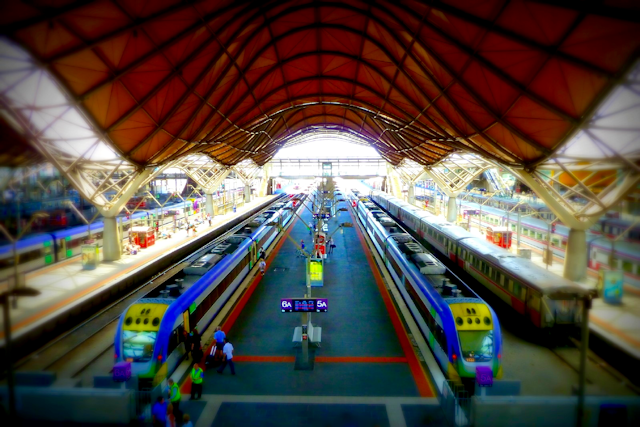In Sydney and Melbourne, the squeeze is on. Population is booming; house prices are still rising; roads and trains are congested. Australian governments generally have ignored the benefits of relating metropolitan and regional planning.
However, some state governments are now investigating more integrated sectoral and spatial planning strategies, initially through shifting public sector jobs to regional centres.
In particular, improved regional rail connections do work. Already rail investments have brought Ballarat, Geelong and other regional centres closer in travel time to Melbourne than many outer suburbs, and this trend will continue.
Further reading: Commuters help regions tap into city-driven growth
Sydney has similar opportunities with regional rail connections, but has not yet exercised them. Rail services to and from Gosford, Newcastle and Wollongong have improved little over recent decades.
Rail bypasses clogged arteries
For decades, policymakers’ preferred solution to congestion has been adding and widening freeways. But promises of faster travel times and freer movement have been illusory. New roads and freeway lanes induce more traffic and will provide short-lived solutions in our biggest cities.
Further reading: Traffic congestion: is there a miracle cure? (Hint: it’s not roads)
These cities are the main drivers of Australia’s national economy, attracting advanced business service professionals and knowledge providers.
Access to high-value jobs, transport arteries that function well, and better-managed population growth will become critically important to urban economies as these cities move towards populations of 8 million people.
In Sydney and Melbourne, critics are claiming that major new road projects such as WestConnex and the Western Distributor will increase central city traffic congestion, particularly for work-related journeys.
Further reading: Modelling for major road projects is at odds with driver behaviour
Victoria proves regional rail works
Contrast that with the success of regional rail development. Victoria has invested several billion dollars in a series of projects. These have raised maximum regional train speeds to provincial cities to 160kph, increased reliability, provided new and much faster trains and transformed frequency.

The 119km peak-hour trip from Ballarat to Melbourne before these investments took two hours, with four trains a day on offer. Today 22 daily trains operate in each direction between Melbourne and Ballarat. Boarding the 4.33pm from Southern Cross delivers passengers to Ballarat 65 minutes later.
From Geelong, the transformation has been even greater. The recently completed Regional Rail Link runs 55 daily trains each way. The project was the first to be approved by Infrastructure Australia, backed by A$3.8 billion in state and Commonwealth funding.
Patronage boom calls for more work
These upgrades, however, have become victims of their own success. Some lines have recorded a 300% increase in patronage. Similar increases are projected for the next decade.
Remarkably, within two years of opening, patronage growth has already reached capacity on the inner part of the Regional Rail Link (which segregates metropolitan from country trains for travel to and from central Melbourne). There is little or no capacity for extra trains to be run in peak times.
Trains are becoming ever more crowded. Long-distance commuters have valued their ability to work, read or sleep on these trains, especially during their homeward journeys. They must now compete for seats with others from rapidly expanding western suburbs, which are yet to gain their own suburban train services.
A short-term fix would create longer trains of eight carriages instead of six. A medium-term fix would electrify and provide separate services to the part of the Geelong line that serves the new dormitory suburbs.
These changes need to be complemented by more frequent and better co-ordinated feeder bus services to stations. In addition, easily accessed large commuter carparks need to be built on vacant land on the Melbourne side of the major regional centres.
In the longer term, the answer lies in providing more multiple tracks to fully segregate suburban and regional trains in suburban areas. Providing robust double-line railways in each corridor will prevent the cascade effect that occurs when trains delay each other on single lines.
The completion of level-crossing removals will also allow higher operating speeds and safer operations. Trains will be able to move progressively to maximum speeds of 200kph where feasible rather than 160kph.
Regional cities must avoid past mistakes
These rail investments will further promote population growth in regional cities. Already, regionally developed services, more affordable housing stock and less frantic lifestyles are acting as attractors.
It is essential to integrate the planning of major regional transport projects with spatial planning to avoid the undesirable results of fragmented policy.
Some regional centres are repeating the worst mistakes of metropolitan low-density urban sprawl by expanding on greenfield sites far from town centres. Modelling of Victorian regional towns has shown that they contain in-fill opportunities to at least double existing populations and provide a range of affordable housing options.
To maintain liveability for expected high population growth, heavy rail investment is vital. Carefully targeted regional rail investment can shrink distance, provide access to more jobs and better lifestyles, and contribute to wider housing choices.
This investment is a critical requirement for continued prosperity in Australia’s largest urban centres.
This article was co-authored by Bill Russell of the Rail Futures Institute, Melbourne.
Find out more about what Victoria can do to overcome the commuter crush at Railway Remedies: Cutting the Crush on Geelong Trains, hosted by the RMIT Centre for Urban Research (CUR) and Deakin University at the Percy Baxter Theatre, Deakin Geelong campus, on Wednesday, August 9.

